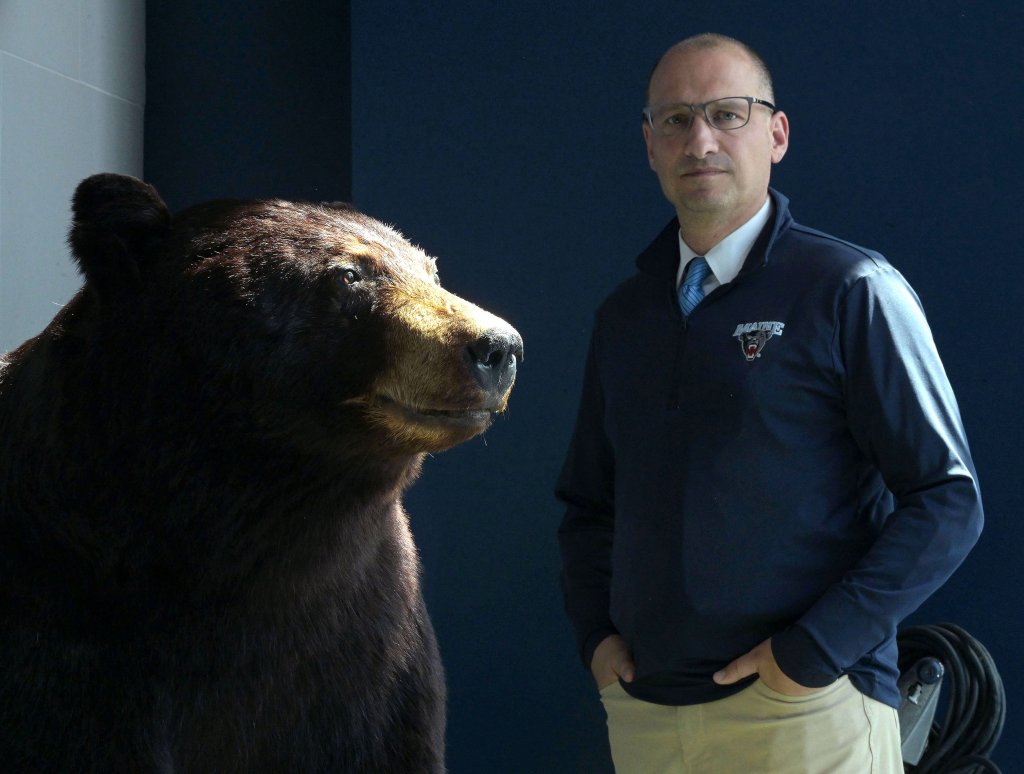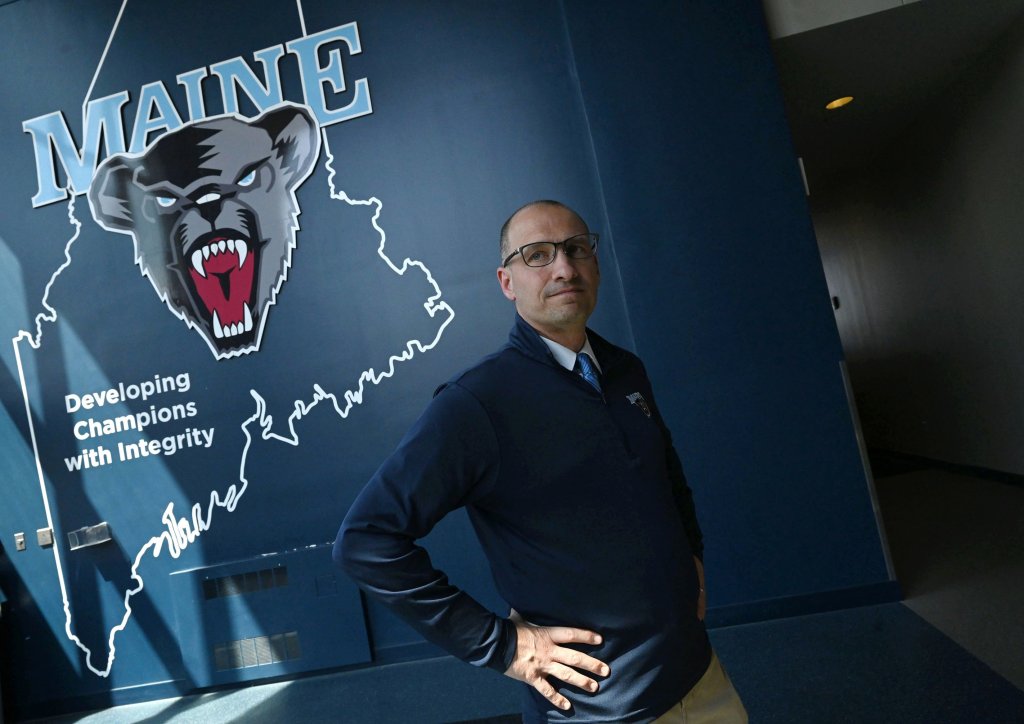
University of Maine men’s hockey senior captain Brandon Holt is aware many other schools are now paying their student-athletes.
He also knows that UMaine won’t be issuing him or his teammates a check this season despite the university opting into a revenue-sharing plan over the summer with the NCAA.
And he’s OK with that.
“I feel like it could create some animosity between teammates, if this guy’s getting this much money and this guy’s not getting as much money,” Holt said. “All I know is, I’m glad when it gets to that level, I won’t be here.”
The college sports landscape changed dramatically in June when the NCAA finalized a settlement plan that allows schools to share up to $20.5 million annually with Division I athletes.
UMaine, the state’s only Division I athletics program, originally indicated it would opt out of the settlement, citing concerns with roster limits. It then reversed course in July when a clause was added that allowed current student-athletes to maintain their spots.
Athletic Director Jude Killy said the university is still assessing the process and how it would work — if and when the university decided to pay its student-athletes.
For now, that’s only happening at the country’s biggest schools in the biggest conferences, and primarily in sports, like football and men’s basketball, that generate the most revenue. It’s estimated that athletes at some schools are making as much as $200,000.
Killy and other coaches of Maine’s highest-profile sports say opting into the settlement was about maintaining flexibility.
“Opting out would guarantee you couldn’t do anything different than how you’re operating right now or how you’ve operated in the past,” Killy said. “Opting in doesn’t mean we’re going to do different things, but it does provide you the ability to do different things if you choose to.”
OPTING IN
UMaine is one of 319 schools that opted into the settlement. In total, more than 80% of Division I schools signed on, with a notable exception being the entire Ivy League.
In Hockey East, the conference in which the UMaine men’s and women’s ice hockey teams compete, only two schools — Boston University and Holy Cross — chose not to participate.
The agreement allows schools to pay student-athletes through revenue sharing. In the 2025-26 school year, participating schools each have an annual cap of $20.5 million for these payments. That’s expected to grow approximately 4% per year.
All of that comes at a cost.
Each member of the America East Conference — UMaine’s primary conference — will now see a 30% reduction of its share of conference revenue each year for the next 10 years, money that is going toward the settlement, whether schools that opted in are paying athletes or not.
Killy said that number can change from year to year, but will be several hundred thousand dollars each year.
“It’s not insignificant,” Killy said. “You do try and map that out so we’re more prepared in the future than we are in the immediacy of it.”
SUPPORTING STUDENT-ATHLETES
UMaine is not alone in navigating this new and changing landscape. At the University of New Hampshire and University of Vermont, schools that, like UMaine, are an island of Division I athletics in a small state, administrators and coaches are studying how they can best serve student-athletes.
UNH Athletic Director Allison Rich said her school is looking at different ways to provide financial support besides direct payments. One option is a cost of attendance stipend, which covers personal expenses that an athletic scholarship does not.
At Vermont, where men’s soccer coach Rob Dow’s team is defending a national title, there are discussions about increasing scholarships and fundraising. Even with a shiny new trophy on display, fundraising is not easy.

“We’re not in Austin or New York or Southern California. Those conversations with local businesses are much harder,” Dow said.
Coaches say, for the most part, recruits don’t ask about getting paid.
“I feel like we’ve been very fortunate in how we recruit. We’ve been open and honest and up front about who we are and what we have. I think we lost one kid because of money, but that was not the reason she gave us,” said Amy Vachon, UMaine’s women’s basketball coach.
It’s important to bring the subject up, she said, to learn how important payment is to a recruit when compared with the other things that go into choosing a school. If it’s a bigger factor for a student than playing time or school location, Vachon knows it’s not going to be a good fit all around.
Student-athletes have also been allowed to capitalize on their name, image and likeness (or NIL) with private businesses deals for a few years now. But NIL deals are still rare at UMaine. At the start of the academic year, only 77 of the 434 UMaine student-athletes (just 18%) had at least onedeal.
Holt said he has an NIL deal with Orono Brewing Company, which basically amounts to him getting the employee discount at the restaurant and free merchandise like T-shirts or hats. As part of the deal, Holt makes social media content for the brewery, including a video he shot with teammate Max Scott of them wake surfing in hockey equipment that has been viewed more than 44,000 times since it was posted on Sept. 12.
Scott Atherley has been involved with UMaine athletics for more than 30 years. First as a soccer player with the now-defunct men’s team in the 1980s, then as a coach. Now in his 27th season as head coach of the women’s soccer team, Atherley has seen a lot of changes in college athletics over the years. What’s happening now, he said, is unlike anything else.
“Where is UMaine going with all of this? I don’t know. That’s an honest answer,” Atherley said. “I think we will continue to diligently look at trends, look at what our like competitors are doing. Certainly, we’ll have to be prepared for all different scenarios.”
In men’s and women’s ice hockey, Maine competes at a national level. In Hockey East, the Black Bears play alongside schools like Boston College, UConn and Providence. Those schools have programs that compete in the so-called power conferences, where direct payment to student-athletes has taken hold through the revenue sharing program.
Does this make Maine feel like it will not be able to continue competing at the highest level of the sport? Not at all.
“College hockey isn’t the same as football and basketball at the SEC level. … That’s a world, outside of building a huge new stadium or something, we’ll never play in,” men’s hockey coach Ben Barr said. “We might not be first to the party, but we just can’t be last either. That’s the challenge we have.”

We invite you to add your comments. We encourage a thoughtful exchange of ideas and information on this website. By joining the conversation, you are agreeing to our commenting policy and terms of use. More information is found on our FAQs. You can modify your screen name here.
Comments are managed by our staff during regular business hours Monday through Friday as well as limited hours on Saturday and Sunday. Comments held for moderation outside of those hours may take longer to approve.
Join the Conversation
Please sign into your CentralMaine.com account to participate in conversations below. If you do not have an account, you can register or subscribe. Questions? Please see our FAQs.